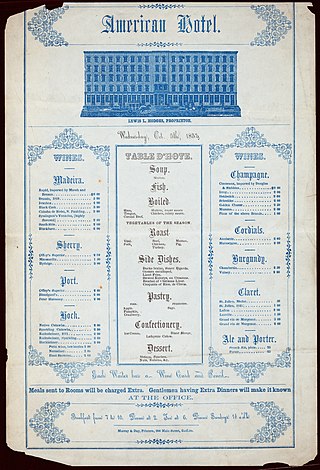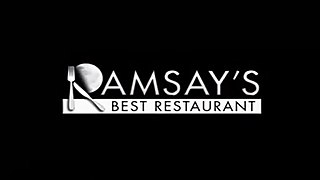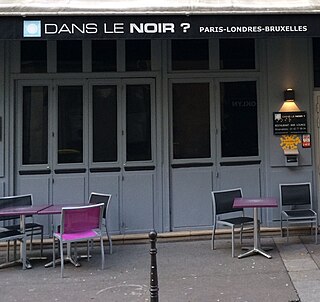
A restaurant is a business that prepares and serves food and drinks to customers. Meals are generally served and eaten on the premises, but many restaurants also offer take-out and food delivery services. Restaurants vary greatly in appearance and offerings, including a wide variety of cuisines and service models ranging from inexpensive fast-food restaurants and cafeterias to mid-priced family restaurants, to high-priced luxury establishments.
Dinner usually refers to what is in many Western cultures the biggest and most formal meal of the day. Historically, the largest meal used to be eaten around midday, and called dinner. Especially among the elite, it gradually migrated to later in the day over the 16th to 19th centuries. The word has different meanings depending on culture, and may mean a meal of any size eaten at any time of day. In particular, it is still sometimes used for a meal at noon or in the early afternoon on special occasions, such as a Christmas dinner. In hot climates, the main meal is more likely to be eaten in the evening, after the temperature has fallen.

Waiting staff (BrE), waiters / waitresses, or servers (AmE) are those who work at a restaurant, a diner, or a bar and sometimes in private homes, attending to customers by supplying them with food and drink as requested. Waiting staff follow rules and guidelines determined by the manager. Waiting staff carry out many different tasks, such as taking orders, food-running, polishing dishes and silverware, helping bus tables, entertaining patrons, restocking working stations with needed supplies, and handing out the bill.

In a restaurant, the menu is a list of food and beverages offered to customers and the prices. A menu may be à la carte – which presents a list of options from which customers choose – or table d'hôte, in which case a pre-established sequence of courses is offered. Menus may be printed on paper sheets provided to the diners, put on a large poster or display board inside the establishment, displayed outside the restaurant, or put on a digital screen. Since the late 1990s, some restaurants have put their menus online.

Service à la française is the practice of serving various dishes of a meal at the same time, with the diners helping themselves from the serving dishes. That contrasts to service à la russe in which dishes are brought to the table sequentially and served individually, portioned by servants.

A buffet can be either a sideboard or a system of serving meals in which food is placed in a public area where the diners serve themselves. A form of service à la française, buffets are offered at various places including hotels, restaurants, and many social events. Buffet restaurants normally offer all-you-can-eat food for a set price, but some measure prices by weight or by number of dishes. Buffets usually have some or mostly hot dishes, so the term cold buffet has been developed to describe formats lacking hot food. Hot or cold buffets usually involve dishware and utensils, but a finger buffet is an array of foods that are designed to be small and easily consumed only by hand, such as cupcakes, slices of pizza, foods on cocktail sticks, etc.

A theme restaurant is a type of restaurant that uses theming to attract diners by creating a memorable experience. Theme restaurants have a unifying or dominant subject or concept, and utilize architecture, decor, special effects, and other techniques, often to create exotic environments that are not normally associated with dining because they are inaccessible, no longer exist, are fictional or supernatural, or taboo. The theme may be further extended through the naming and choices of food, though food is usually secondary to entertaining guests.

Room service or in-room dining is a hotel service enabling guests to choose items of food and drink for delivery to their hotel room for consumption. Room service is organized as a subdivision within the food and beverage department of high-end hotel and resort properties. It is uncommon for room service to be offered in hotels that are not high-end, or in motels. Room service may also be provided for guests on cruise ships. Room service may be provided on a 24-hour basis or limited to late night hours only. Due to the cost of customized orders and delivery of room service, prices charged to the patron are typically much higher than in the hotel's restaurant or tuck shop, and a gratuity is expected in some regions.

In restaurant terminology, a table d'hôte menu is a menu where multi-course meals with only a few choices are charged at a fixed total price. Such a menu may be called prix fixe. The terms set meal and set menu are also used.

A full-course dinner is a meal with multiple courses, almost invariably eaten in the evening or afternoon. Most Western-world multicourse meals follow a standard sequence, influenced by traditional French haute cuisine. It commonly begins with an appetizer, followed by the main course, the salad course, and eventually the dessert, but the exact sequence varies widely. Full-course dinners are generally very formal as well as very expensive, and can have as few as 3 or as many as 21 courses. Some major styles include service à la russe and service à la française.

Table manners are the rules of etiquette used while eating, which may also include the use of utensils. Different cultures observe different rules for table manners. Each family or group sets its own standards for how strictly these rules are to be followed.

Masayoshi "Masa" Takayama is a Japanese chef and restaurateur. He is the owner of Masa, a three-Michelin-starred Japanese and sushi restaurant in Manhattan, New York City. He is also owner of Bar Masa, with two locations: one adjacent to his New York City restaurant, and one in the Aria Resort & Casino on the Las Vegas Strip in Paradise, Nevada.
Restaurants fall into several industry classifications, based upon menu style, preparation methods and pricing, as well as the means by which the food is served to the customer. This article mainly describes the situation in the US, while categorisation differs widely around the world.

Customs and etiquette in Chinese dining are the traditional behaviors observed while eating in Greater China. Traditional Han customs have spread throughout East Asia to varying degrees, with some regions sharing a few aspects of formal dining, which has ranged from guest seating to paying the bill.

A table reservation is an arrangement made in advance to have a table available at a restaurant. While most restaurants in the vast majority of the world do not require a reservation, and some do not have a policy or simply any channel for making one, so-called higher-end restaurants mainly in overcrowded cities often require a reservation, and some may have tables booked for weeks in advance. At particularly exclusive venues, it may be impossible to make a reservation on the same day as the planned visit.

Ramsay's Best Restaurant is a television programme featuring British celebrity chef Gordon Ramsay broadcast on Channel 4. During the series restaurants from all over Britain competed in order to win the "Ramsay's Best Restaurant" title. The initial 16 restaurants were selected by Ramsay from a pool of some 12,000 entries submitted by Channel 4 viewers.

Dark dining is the act of eating a meal without seeing the food that is being eaten. The basic concept is that the removal of vision enhances the other senses and increases gastronomic pleasure. Since 1999, specialised dark restaurants have opened in many parts of the world.

Na Laga'at is a nonprofit organization founded in 2002 by Adina Tal and Eran Gur around the first of its kind in the world ensemble whose actors are all deafblind. The organization established a unique cultural center at the Levantbondet House in the Port of Jaffa in Tel Aviv. The center is a platform for creative arts, which promote equal and open dialogue and lead to social change built on the belief in the human spirit and its ability to reach out and make a change.
Kitchen Table is a restaurant located in London, England. It was opened in 2012 by husband and wife, James Knappett and Sandia Chang. Along with the restaurant, they also opened a Champagne bar called Bubbledogs at the same site, but this was closed permanently due to the COVID-19 pandemic, with the old space being converted into a lounge for customers dining at Kitchen Table.
Karen's Diner is an Australian-American chain of theme restaurants. The restaurant is known for advertising a deliberately unpleasant dining experience, and staff are instructed to insult customers throughout their meal. The restaurant's name came from the internet slang term Karen, used to describe an older white woman who is stereotypically rude.















